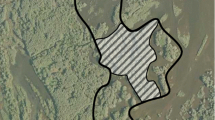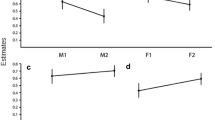Abstract
In sexually dimorphic ungulates, males generally spend less time foraging than females, possibly because of difference in body mass or because of the energetic requirements of lactation. The relationship between body size and foraging time has received little attention at the intra-specific level, because few studies have documented activity budgets for individuals of known size. Bighorn rams are a good model to explore how body mass affects foraging time, because they range in mass from 55 to 140 kg. We examined how the foraging time of bighorn rams varied according to individual characteristics. We observed rams in a marked population and constructed time budgets during the 3 months preceding the rut. We determined ram social rank based on agonistic encounters and collected fecal samples to count lungworm larvae. Time spent foraging was negatively correlated with body mass. After accounting for age differences, larger rams spent less time foraging and more time lying than smaller rams. Among rams aged 6–12 years, dominants spent less time feeding than subordinates, while fecal output of lungworm larvae was negatively correlated with foraging time for rams of all ages. Body mass accounts for much of the individual variation in foraging time, suggesting that sexual dimorphism is important in explaining differences in feeding time between males and females.



Similar content being viewed by others
References
Altmann J (1974) Observational study of behavior: sampling methods. Behaviour 49:227–267
Bassano B, von Hardenberg A, Pelletier F, Gobbi G (2003) A method to weigh free-ranging ungulates without handling. Wildl Soc Bull 31:1205–1209
Bell RHV (1971) A grazing ecosystem in the Serengeti. Sci Am 225:86–93
Bon R, Rideau C, Villaret J-C, Joachim J (2001) Segregation is not only a matter of sex in Alpine ibex, Capra ibex ibex. Anim Behav 62:495–504
Bonneaud C, Mazuc J, Gonzalez G, Haussy C, Chastel O, Faivre B, Sorci G (2003) Assessing the cost of mounting an immune response. Am Nat 161:367–379
Buchanan KL, Evans MR, Goldsmith AR, Bryant DM, Rowe LV (2001) Testosterone influences basal metabolic rate in male house sparrows: a new cost of dominance signalling? Proc R Soc Lond B 268:1337–1344
Clutton-Brock TH, Guinness FE, Albon SD (1982a) Red deer: behavior and ecology of two sexes. University of Chicago Press, Chicago
Clutton-Brock TH, Iason GR, Albon SD, Guinness FE (1982b) Effects of lactation on feeding behaviour and habitat use in wild Red deer hinds. J Zool 198:227–236
Conradt L (1998) Could asynchrony in activity between the sexes cause intersexual social segregation in ruminants? Proc R Soc Lond B 265:1359–1363
Creel S (2001) Social dominance and stress hormones. Trends Ecol Evol 16:491–497
Creel S, Creel NM, Monfort SL (1996) Social stress and dominance. Nature 379:212
Demment MW (1982) The scaling of ruminoreticulum size with body weight in East African ungulates. Afr J Ecol 20:43–47
Demment MW, Van Soest PJ (1985) A nutritional explanation for body-size patterns of ruminant and nonruminant herbivores. Am Nat 125:641–672
Dobson FS, Risch TS, Murie JO (1999) Increasing returns in the life history of Columbian ground squirrels. J Anim Ecol 68:73–86
Festa-Bianchet M (1991) Numbers of lungworm larvae in feces of bighorn sheep: yearly changes, influence of host sex, and effects on host survival. Can J Zool 69:547–554
Forrester SG, Lankester MW (1997) Extracting protostrongylid nematode larvae from ungulate feces. J Wildl Dis 33:511–516
Geist V (1971) Mountain sheep. University of Chicago Press, Chicago
Gross JE, Alkon PU, Demment MW (1996) Nutritional ecology of dimorphic herbivores: digestion and passage rates in Nubian ibex. Oecologia 107:170–178
Hass CC, Jenni DA (1991) Structure and ontogeny of dominance relationships among bighorn rams. Can J Zool 69:471–476
Hogg JT (1984) Mating in bighorn sheep: multiple creative male strategies. Science 225:526–529
Hogg JT (1987) Intrasexual competition and mate choice in Rocky Mountain bighorn sheep. Ethology 75:119–144
Hudson RJ (1985) Body size, energetics, and adaptive radiation. In: Hudson RJ, White RG (eds) Bioenergetics of wild herbivores. CRC Press, Boca Raton, Fla., pp 1–24
Illius WA, Gordon IJ (1987) The allometry of food intake in grazing ruminants. J Anim Ecol 56:989–999
Jarman PJ (1974) The social organization of antelope in relation to their ecology. Behaviour 48:215–267
Jenkins SH (2002) Data pooling and type I errors: a comment on Leger & Didrichsons. Anim Behav 63:F9-F11
Komers PE, Messier F, Gates CC (1993) Group structure in wood bison: nutritional and reproductive determinants. Can J Zool 71:1367–1371
Kyriazakis I, Anderson DH, Oldham JD, Coop RL, Jackson F (1996) Long-term subclinical infection with Trichostrongylus colubriformis: effects on food intake, diet selection and performance of growing lambs. Vet Parasitol 61:297–313
Kyriazakis I, Tolkamp BJ, Hutchings MR (1998) Towards a functional explanation for the occurence of anorexia during parasitic infections. Anim Behav 56:265–274
Leger DW, Didrichsons IA (1994) An assessment of data pooling and some alternatives. Anim Behav 48:823–832
Machlis L, Dodd PWD, Fentress JC (1985) The pooling fallacy: problems arising when individuals contribute more than one observation to the data set. Z Tierpsychol 68:201-214
Mysterud A (1998) The relative roles of body size and feeding type on activity time of temperate ruminants. Oecologia 113:442–446
Owen-Smith NR (1988) Megaherbivores. Cambridge University Press, Cambridge
Owen-Smith NR (1992) Grazers and browsers: ecological and social contrasts among African ruminants. In: Spitz F, Janeau G, Gonzalez G, Aulagnier S (eds) Ongulés/Ungulates 91. S.F.E.P.M.-I.R.G.M., Paris, Toulouse, pp 175–181
Owen-Smith NR (1998) How high ambient temperature affects the daily activity and foraging time of a subtropical ungulate, the greater kudu (Tragelaphus strepsiceros). J Zool 246:183–192
Pelletier F, Bauman J, Festa-Bianchet M (2003) Fecal testosterone in bighorn sheep (Ovis canadensis): behavioural and endocrine correlates. Can J Zool 81:1678–1684
Pérez-Barberia FJ, Gordon IJ (1999) The relative roles of phylogeny, body size and feeding style on the activity time of temperate ruminants: a reanalysis. Oecologia 120:193–197
Pettorelli N, Gaillard JM, Van Laere G, Duncan P, Kjellander P, Liberg O, Delorme D, Maillard D (2002) Variations in adult body mass in roe deer: the effects of population density at birth and of habitat quality. Proc R Soc Lond B 269:747–753
Roberts G (1996) Why individual vigilance declines as group size increases? Anim Behav 51:1077–1086
Ruckstuhl KE (1998) Foraging behaviour and sexual segregation in bighorn sheep. Anim Behav 56:99–106
Ruckstuhl KE (1999) To synchronise or not to synchronise: a dilemma for young bighorn males? Behaviour 136:805–818
Ruckstuhl KE, Festa-Bianchet M (2001) Group choice by subadult bighorn rams: trade-offs between foraging efficiency and predator avoidance. Ethology 107:161–172
Ruckstuhl KE, Kokko H (2002) Modelling sexual segregation in ungulates: effects of group size, activity budgets and synchrony. Anim Behav 64:909–914
Ruckstuhl KE, Neuhaus P (2002) Sexual segregation in ungulates: a comparative test of three hypotheses. Biol Rev 77:77–96
Ruckstuhl KE, Festa-Bianchet M, Jorgenson J (2003) Bites rates in Rocky Mountain bighorn sheep (Ovis canadensis): effects of season, age, sex and reproductive status. Behav Ecol Sociobiol 54:167–173
Sayre RW, Seabloom RW (1994) Summer activity patterns of bighorn ewes in the Northern Great Plains. In: Biennial Symposium of the Northern Wild Sheep and Goat Council, Cranbrook, B.C., vol 8, pp 104–109
Sokal RR, Rohlf FJ (1981) Biometry, 2nd edn. Freeman, San Francisco
Steele BM, Hogg JT (2003) Measuring individual quality in conservation and behavior. In: Festa-Bianchet M, Apollonio M (eds) Animal behavior and wildlife conservation. Island Press, Washington, pp 243–269
Sutherland I (2003) Fecal mass and parasite strategies. Trends Parasitol 19:68
Vries H de (1995) An improved test of linearity in dominance hierarchies containing unknown or tied relationships. Anim Behav 50:1375–1389
Vries H de (1998) Finding a dominance order most consistent with a linear hierarchy: a new procedure and review. Anim Behav 55:827–843
Vries H de, Netto WJ, Hanegraaf PLH (1993) Matman: a program for the analysis of sociometric matrices and behavioural transition matrices. Behaviour 125:157–175
Acknowledgments
We thank Y. Gendreau, É. Viollet, K.A. Page and C. Feder for help in the field. We are grateful to A. von Hardenberg for assistance with statistics. For critical comments on the manuscript, we thank Kathreen Ruckstuhl, Norman Owen-Smith and Jean-Michel Gaillard. We also thank Jack Hogg for his continuous help and advice. We dedicate this paper to the late Ian Ross, who made a major contribution to this long-term study by capturing and tagging bighorns from 1989 to 2002. Financial support was provided by a Challenge Grant in Biodiversity financed trough the Alberta Conservation Association and the University of Alberta (to F.P.), NSERC Discovery grant to M.F.-B. and a NSERC scholarship to F.P. We thank the Kananaskis Field Stations (University of Calgary) for logistic support. This research project (protocol MFB 02) was approved by the Animal Care Committee of the Université de Sherbrooke, an affiliate of the Canadian Council on Animal Care.
Author information
Authors and Affiliations
Corresponding author
Additional information
Communicated by P. Heeb
Rights and permissions
About this article
Cite this article
Pelletier, F., Festa-Bianchet, M. Effects of body mass, age, dominance and parasite load on foraging time of bighorn rams, Ovis canadensis. Behav Ecol Sociobiol 56, 546–551 (2004). https://doi.org/10.1007/s00265-004-0820-7
Received:
Revised:
Accepted:
Published:
Issue Date:
DOI: https://doi.org/10.1007/s00265-004-0820-7




